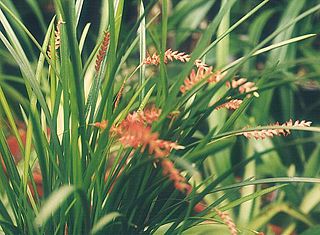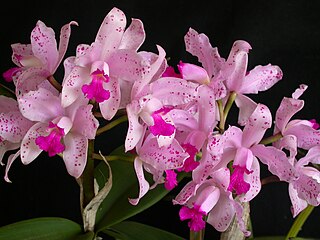
Gymnadenia conopsea, commonly known as the fragrant orchid or chalk fragrant orchid, is a herbaceous plant of the family Orchidaceae native to northern Europe.

Ansellia is considered a monotypic genus of orchid, with only one species, Ansellia africana, commonly known as African ansellia or leopard orchid, however, it may in fact be a complex group of species which share common floral structure and growth habit.

Hosta is a genus of plants commonly known as hostas, plantain lilies and occasionally by the Japanese name gibōshi. Hostas are widely cultivated as shade-tolerant foliage plants. The genus is currently placed in the family Asparagaceae, subfamily Agavoideae, and is native to northeast Asia. Like many "lilioid monocots", the genus was once classified in the Liliaceae. The genus was named by Austrian botanist Leopold Trattinnick in 1812, in honor of the Austrian botanist Nicholas Thomas Host. In 1817, the generic name Funkia was used by German botanist Kurt Sprengel in honor of Heinrich Christian Funck, a collector of ferns and alpines; this was later used as a common name and can be found in some older literature.

Dendrochilum was a genus of epiphytic, lithophytic and a few terrestrial flowering plants in the orchid family (Orchidaceae). It is now considered to be a synonym of Coelogyne Lindl. The name of this genus was derived from Ancient Greek words dendron ("tree"), and either cheilos ("lip") or chilos, alluding to either the flowers' large lip or to their epiphytic growth. These orchids are popular among fans of non-traditional orchid curiosities.

Spiranthes spiralis, commonly known as autumn lady's-tresses, is an orchid that grows in Europe and adjacent North Africa and Asia. It is a small grey-green plant. It forms a rosette of four to five pointed, sessile, ovate leaves about 3 cm (1.2 in) in length. In late summer an unbranched stem of about 10–15 cm (3.9–5.9 in) tall is produced with approximately four sheath-shaped leaves. The white flowers are about 5 mm (0.20 in) long and have a green spot on the lower lip. They are arranged in a helix around the upper half of the stalk. The species is listed in Appendix II of CITES as a species that is not currently threatened with extinction but that may become so. Autumn lady's-tresses are legally protected in Belgium and the Netherlands.

Caladenia flava, commonly known as cowslip orchid, is a species of orchid endemic to the south-west of Western Australia. It is a relatively common orchid with a single, hairy leaf and up to three yellow flowers which often have red markings. In 2001 three subspecies were named and a fourth is recognised but not as yet formally described.

Hammarbya paludosa is a small orchid commonly known as bog orchid, bog adder's-mouth or bog adder's-mouth orchid. It grows in bogs in temperate and subarctic regions of the Northern Hemisphere.

Cattleya aclandiae, or Lady Ackland's cattleya, is a species of orchid from the genus Cattleya, named in honor of Lady Lydia Elizabeth Ackland, wife of Sir Thomas Dyke Acland, 10th Baronet who was the first European to grow the plant successfully. The illustration of the plant which accompanied its first description was based on a drawing by Lady Ackland. The genus was named in honour of William Cattley, a prominent British merchant and horticulturist.

Cattleya amethystoglossa is a bifoliate species of orchid from the genus Cattleya.
Epidendrum chlorinium is a terrestrial species of reed-stemmed Epidendrum found in mountainous regions of the states of Minas Gerais, São Paulo, and Espiritu Santo, Brazil, at altitudes of 1–1.5 km.

Vanda cristata is a species of orchid found growing in the Himalaya from Bangladesh, India, Nepal, Bhutan to China at elevations of 600 – 2300 meters.

Bulbophyllum exiguum, commonly known as the tiny strand orchid, is a species of epiphytic or lithophytic orchid that is endemic to eastern Australia. It has small, roughly spherical pseudobulbs each with a single leaf and up to three small creamy white to yellow flowers emerging from the base of the pseudobulb. This orchid grows in rainforest and dry forest where it often covers the branches of trees or rocks on which it grows.

Praecoxanthus aphyllus, commonly known as leafless orchid, is the only species of the flowering plant genus Praecoxanthus in the orchid family, Orchidaceae and is endemic to the south-west of Western Australia. Plants in flower lack a true leaf, although those plants that are not flowering do possess a green leaf. This species is one of the first orchids to flower each year and its creamy white, fragrant flower easily distinguishes it from other species.

Trichoglottis atropurpurea, the dark purple trichoglottis, is a species of orchid endemic to the Philippines. This hot to warm growing epiphyte was first found growing in mangrove swamps in the islands of Biliran, Catanduanes, Mindanao and Polillo. The plant shares the same appearance with T. philippinensis except for the rich dark color of the blooms and slight variation of the perianth. This species was first described in 1877 by the German botanist Heinrich Gustav Reichenbach, an expert on the orchid family. At that time, thousands of newly discovered orchids were being sent back to Europe, and he was responsible for identifying, describing and classifying many of these new discoveries.

Caladenia dimidia, commonly known as the chameleon orchid is a species of orchid endemic to the south-west of Western Australia. It has a single hairy leaf and one or two yellow, cream-coloured or pinkish flowers. It is a variable species, similar to the Joseph's spider orchid but has a more northerly distribution and smaller flowers.

Caladenia ambusta, commonly known as the Boranup spider orchid, is a plant in the orchid family Orchidaceae and is endemic to the south-west of Western Australia. It has a single erect, linear leaf and a single creamy-coloured flower on a stem 27–35 cm (11–14 in) high. It is only known from a relatively small area south-west of Margaret River growing in deep sand in shrubland and woodland and only flowering profusely after fire.
Caladenia behrii, commonly known as pink-lipped spider orchid is a plant in the orchid family Orchidaceae and is endemic to South Australia. It has a single narrow, hairy leaf and one or two creamy-white flowers with pink tips in early spring.

Cattleya iricolor is a species of orchid native to the eastern montane forests of Ecuador and Peru.

Entada burkei, commonly known as the elephant root or sumach bean, is a deciduous shrub or small tree in the mimosoid clade of legumes. It is native to southern Africa, in Mozambique, Zimbabwe, Botswana, and the Northern Provinces of South Africa. It grows on rocky slopes or ridges, in either woodland, grassland or scrubland. The species is named after the botanist Joseph Burke.

Phalaenopsis natmataungensis is a species of orchid endemic to Myanmar. The specific epithet natmataungensis refers to Nat Ma Taung, Myanmar. The mountain slopes are covered in natural, seasonally dry forests that are mainly composed of deciduous trees. These areas are generally not disturbed by agriculture.


















